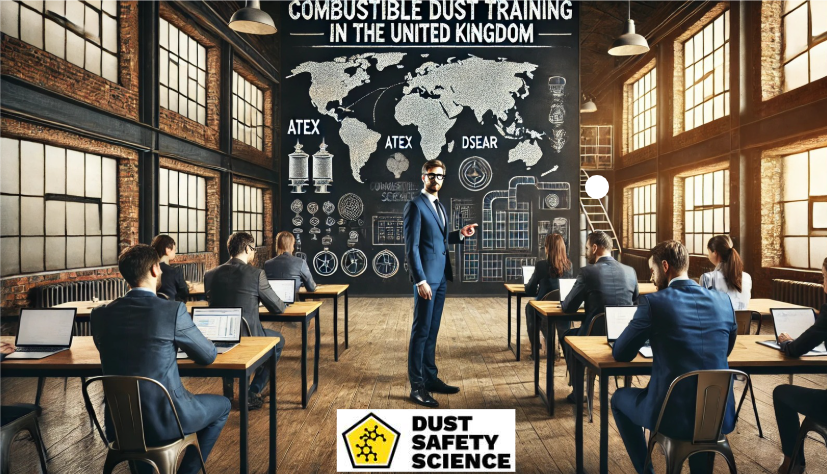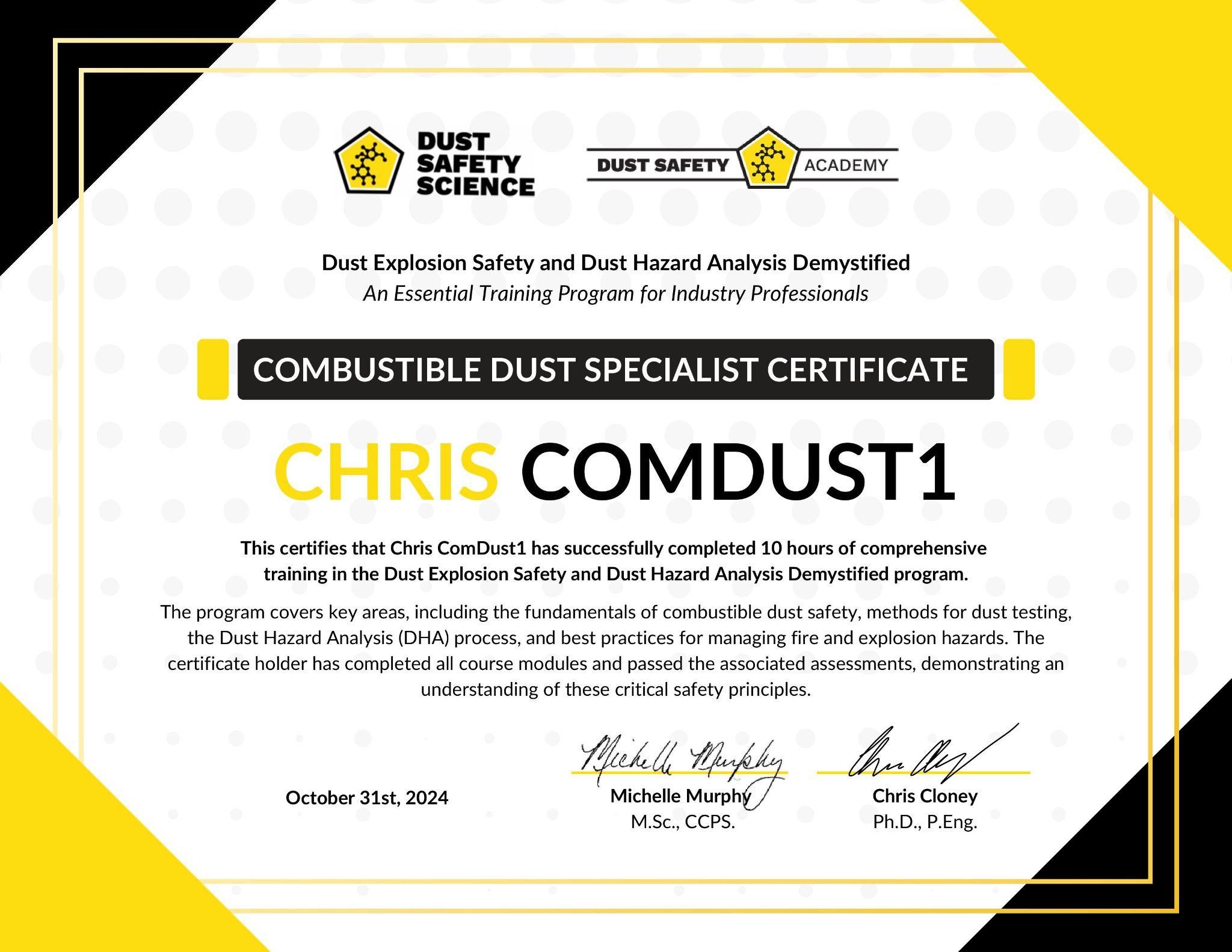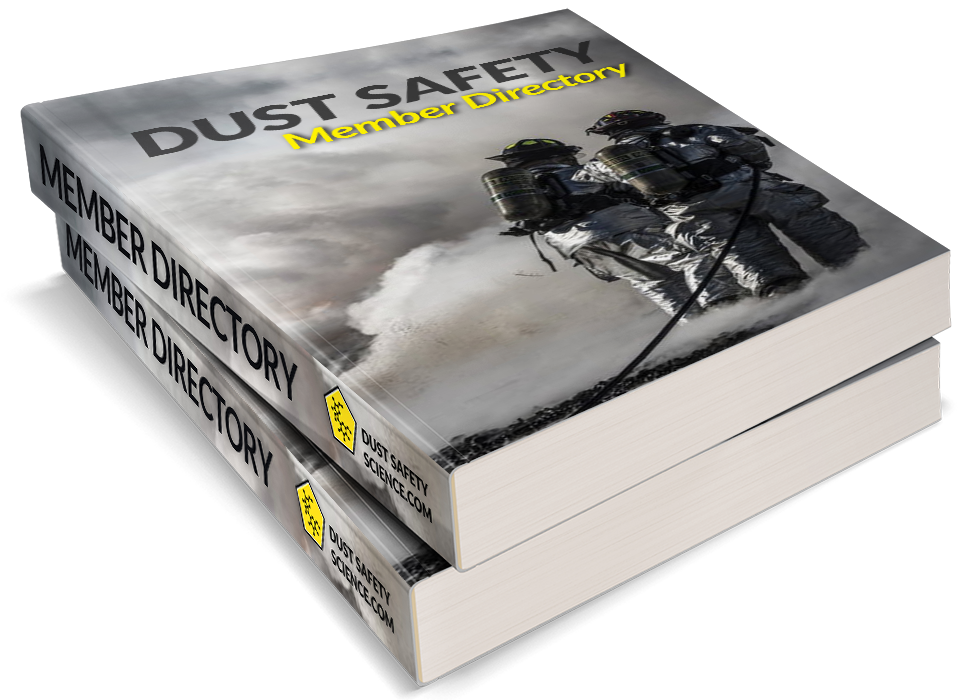Published February 4, 2025 Authored by Dr. Chris Cloney and Jon Barrett of Dust Safety Science

Combustible Dust Training in the United Kingdom: Ensuring Compliance with DSEAR 🌍
Dust explosions pose a critical safety risk in various industries worldwide, including the United Kingdom and Europe. Industries such as agriculture, food processing, mining, and manufacturing are particularly vulnerable to these hazards due to the abundance of combustible materials and the lack of stringent safety measures. Past and present combustible dust explosions highlight the pressing need for comprehensive safety protocols and combustible dust training to mitigate risks effectively. To mitigate these risks, organizations must comply with the Dangerous Substances and Explosive Atmospheres Regulations, (DSEAR), which outline legal requirements for managing explosive atmospheres.
Some of the countries in Europe and the United Kingdom affected by combustible dust explosions include: England, Scotland, Wales (which collectively make up Great Britain) and Northern Ireland, Spain, Portugal, Germany, Ireland, Italy, Albania, Latvia, Andorra, Liechtenstein, Armenia, Lithuania, Austria, Luxembourg, Azerbaijan, Malta, Belarus, Moldova, Belgium, Monaco, Bosnia, Herzegovina, Montenegro, Bulgaria, Netherlands, Croatia, Norway, Cyprus, Poland, Czech Republic, Portugal, Denmark, Romania, Estonia, Russia, Finland, San Marino, Former Yugoslav Republic of Macedonia, Serbia, France, Slovakia, Georgia, Slovenia, Germany, Spain, Greece, Sweden, Hungary, Sweden, Iceland, Switzerland, Ireland, Turkey, Italy, Ukraine, and Kosovo.
In this article, we will explore the importance of combustible dust training, highlight the unique online combustible dust training courses of Dust Safety Science, and provide details on worldwide combustible dust training programs with Dust Safety Science.
One of the most effective methods for addressing combustible dust hazards is Dust Hazard Analysis, (DHA). A DHA is a proactive measure to identify potential risks and implement controls to prevent dust explosions. This article explores the importance of dust explosion safety in Latin America, provides an overview of DHA, and emphasizes the need for targeted training programs to enhance industrial safety. Beyond the tragic loss of life, dust explosions can cause extensive property damage, production downtime, and financial setbacks. Combustible dust, produced in manufacturing operations, can ignite under the right conditions, leading to explosions with catastrophic consequences.
Every year, combustible dust explosions and incidents happen across all manufacturing industries, causing widespread destruction, injuries, and even loss of life. The financial toll is staggering, with billions in property damage and legal costs. Despite the risks, many industrial facilities and manufacturing plants must tackle the challenges of combustible dust.
The question is: Are you doing enough to protect your business and employees from dust explosions? To create a safer workplace, visit worldwide combustible dust training programs with Dust Safety Science.
Legal Requirements: Compliance with DSEAR
In the United Kingdom, combustible dust hazards fall under the scope of the Dangerous Substances and Explosive Atmospheres Regulations, (DSEAR). Enforced by the Health and Safety Executive, (HSE), DSEAR requires businesses to:
- Assess risks associated with explosive atmospheres, including combustible dust.
- Implement control measures to eliminate or reduce explosion risks.
- Classify hazardous zones based on the likelihood of explosive atmospheres forming.
- Provide training and instruction to employees working in areas with combustible dust.
- Ensure proper maintenance and housekeeping to prevent dust accumulation.
Failure to comply with DSEAR can lead to legal penalties, operational disruptions, and heightened safety risks. Training is vital in ensuring organizations understand and adhere to these regulations.
How to Get Started with Combustible Dust and Dust Explosion Training
Whether your organization operates locally or globally, Dust Safety Science has the resources and expertise to help you enhance safety and compliance. Explore Custom Training Solutions or learn more about the Worldwide Training Program.
The Devastating Consequences of Dust Explosions 💥
Combustible dust incidents don’t just cause physical damage, they devastate lives. Workers face injuries or fatalities, businesses lose productivity, and the aftermath often leads to reputational damage and regulatory fines. To address this hidden threat, proactive safety measures are essential. Enter Dust Explosion Safety and Dust Hazard Analysis Demystified Online Training a game changer in industrial safety.
The Need for Combustible Dust Training: Training on Standards and Codes Across the United Kingdom
Safety training empowers businesses to identify, control, and mitigate combustible dust hazards. A well-structured training program ensures compliance with standards, enhances workplace safety, and promotes operational efficiency. Dust Safety Science has successfully delivered training to industries worldwide, addressing diverse cultural, regulatory, and operational needs. Dust Safety Science’s Worldwide Combustible Dust Training Program is designed to ensure every client receives targeted and effective education.
To take the first step toward creating a safer workplace, visit Dust Explosion Safety and Dust Hazard Analysis Demystified Online Training. The training solutions equip organizations to handle combustible dust risks effectively.
Understanding Combustible Dust Explosions 💥
What is Combustible Dust?
Combustible dust is made of fine particulate solids that can ignite and explode when dispersed in the air. These particles, ranging from wood shavings to powdered metals, form an explosive mix when conditions are optimum.
The Dust Explosion Pentagon identifies five critical elements required for a dust explosion:
- Fuel: Combustible dust.
- Oxygen: Present in the air.
- Ignition Source: Heat, sparks, or flames.
- Dispersion: Particles suspended in air.
- Confinement: Enclosed spaces that amplify explosive force.
When all five elements converge, the results can be catastrophic.
Common Causes of Dust Explosions in the United Kingdom
- Overheated Bearings: Inadequately maintained equipment is a frequent ignition source.
- Electrical Failures: Faulty wiring, static electricity, or faulty equipment can lead to sparks, including Walkie Talkies, Cell phones, and Microphones.
- Dust Accumulation: Poor housekeeping allows dust to collect and become a serious hazard.
- Mechanical Malfunctions: Equipment failures can generate heat and friction, igniting dust clouds.
Industries at Risk of Combustible Dust Explosions 🏭
While combustible dust hazards exist in many industries, some industries are more prone to combustible dust explosions than others:
- Food Processing: Soybean, flour, coffee, rice, cotton, beans, cacao, wheat, cocoa, sugar, corn, maize, nuts, and grain dust.
- Woodworking: Sawdust and fine wood particles.
- Pharmaceuticals: Fine powders, plastics, and chemicals.
- Biomass: Wood, wood residues, tobacco, energy crops, agricultural residues. including straw, peat, and organic waste from industry and households.
- Coal: Coal Mines, coal dust, and Coking coal dust.
- Fireworks: Metallic fine dust such as Aluminum, magnesium, titanium, zinc, iron filings, strontium and barium salts
- Metalworking: Aluminum, magnesium, zirconium, and other metallic dust.
Each industry requires customized training to manage unique risks. Learn how tailored training can address these challenges by visiting Dust Explosion Safety and Dust Hazard Analysis Demystified Online Training.
Historical Dust Explosion Prevalence in the United Kingdom and Europe
Dust explosions are not limited to any single region or industry, but the United Kingdom and Europe have seen notable incidents over recent decades, emphasizing the need for targeted prevention The potential for incidents exists, especially in agriculture and manufacturing sectors where dust is prevalent. Ongoing research and improved safety standards remain vital to preventing tragedies associated with combustible dust in the region.
Notable Case Studies in the United Kingdom and Europe:
- Giacomelli’s Bakery Flour Dust Explosion of 1785, was the first documented dust explosion and occurred in Turin, Italy. Count Carlo Ludovico Morozzo di Bianzè investigated and recorded the incident and flour dust explosion on December 14th, 1785.
- July 17, 2015, Cheshire Fire and Rescue Service’s Macclesfield and Congleton Fire Stations responded to the Wood Treatment Ltd. at Bosley Mill in Congleton. The wood flour mill at Wood Treatment ltd was destroyed by at least three dust explosions, from wood dust and a dust cloud. A primary dust explosion occurred within the process, stirring up previously settled dust within the mill, leading to a large secondary dust explosion.
- According to The British Broadcasting Corporation (BBC), on August 19, 2020, the Tilbury Port Grain store blast caused by ‘dust explosion’
- On November 7, 2022, the Leader reported a dust explosion and fire at a foam rubber manufacturer in Rhydymwyn, Wales, UK.
- According to Wikipedia, during the Senghenydd Colliery coal mine disaster in May 1901, three underground explosions at the colliery killed 81 miners. The most likely cause was a spark from underground signaling equipment that could have ignited any firedamp present.
- According to the research of the Institution of Chemical Engineers, Symposium Series N. 54, Crown Copyright, On 2 July 2003, a dust explosion occurred in the Sugar Silo Facility at British Sugar Refinery in Cantley, Norfolk.
- According to Reuters, on July 26, 2024, a fireworks explosion with one dead in a Bulgaria firework factory explosion.
- According to Wikipedia, The Culemborg fireworks disaster (Dutch: Vuurwerkramp in Culemborg, also known as the Klap van Culemborg “Bang of Culemborg” occurred on Thursday 14 February 1991 in Culemborg, the Netherlands.
- According to Wikipedia, The Enschede fireworks disaster was a catastrophic fireworks explosion on 13 May 2000 in Enschede, Netherlands.
- According to the INSTITUT NATIONAL DE L’ENVIRONNEMENT INDUSTRIEL ET DES RISQUES, INERIS – BLAYE – Summary report – July 1998, “Explosion of a grain silo BLAYE (France)” Summary Report, Ministry for National and Regional Development and the Environment, Authors and Expert Appraisers: F. MASSON and J.F. LECHAUDEL, presented on Wednesday August 20th 1997, an accident occurred at the grain storage facilities of the Société d’Exploitation Maritime Blayaise (SEMABLA) at Blaye (in the Gironde department). The accident mainly affected a vertical grain storage silo. The collapse of a major part of this facility, notably on the administrative and technical buildings, caused 12 victims (11 deaths and 1 injury).
- According to the Smithsonian Magazine, spontaneous combustion of coal, which then became a fire, might have weakened the hull of the passenger ship, Titanic. The coal fire had started as early as three weeks before the Titanic set out for its maiden voyage, on April 15, 1912, from Liverpool, England, but was ignored for fear of bad press and the desire to keep the ship on schedule. According to Wikipedia, the RMS Titanic had a normal coal-carrying capacity of 6,611 tons, with an additional 1,092 tons of coal stored in a reserve bunker. According to research on MDPI, (Multidisciplinary Digital Publishing Institute), Research on the Combustion Characteristics of Coal Piles and the Fire Risks of Closed Coal Bunkers has been updated.
Combustible dust incidents continue to occur worldwide and in many industries, as presented in this combustible dust research and incident database from Dust Safety Science.
Why Combustible Dust Safety Training is Crucial in the United Kingdom and Europe
Europe’s industrial sectors are rapidly evolving, and many countries are expanding their manufacturing capabilities. With industries such as agriculture (grain storage), sugar refining, and mining becoming more prominent, combustible dust hazards are increasing. Without adequate training on combustible dust standards and codes, businesses risk exposure to workplace explosions, environmental damage, and legal consequences.
Key Reasons Why Training is Essential:
- Prevention of Dust Explosions: Combustible dust explosions can cause fatalities, severe injuries, and widespread damage. Proper training helps mitigate the risk of explosions.
- Compliance with Regulatory Requirements: Many countries in South America are enhancing their safety standards, and training ensures businesses meet these evolving requirements.
- Improved Workplace Safety: Employees trained in the hazards of combustible dust are better prepared to recognize risks and implement effective safety measures.
- Reduction in Liability and Operational Costs: Organizations can avoid costly accidents, fines, and downtime by complying with safety regulations and maintaining safe working environments.
Regulatory Compliance in the United Kingdom and Europe
According to Wikipedia, the ATEX directives are two of the EU directives describing the minimum safety requirements for workplaces and equipment used in explosive atmospheres. The ATEX name is an initialization of the term ATmosphères EXplosibles, (French for “explosive atmospheres”).
ATEX is the name commonly given to the 2 European Directives for controlling explosive atmospheres:
- Directive 99/92/EC (also known as ‘ATEX 137’ or the ‘ATEX Workplace Directive’): This covers the minimum requirements for improving the health and safety protection of workers potentially at risk from explosive atmospheres. The text of the Directive and the supporting EU produced guidelines are available on the EU-website.
The Dangerous Substances and Explosive Atmospheres Regulations (DSEAR) implement the requirements of this Directive in Great Britain (England, Scotland and Wales). Further information can be found in the section on explosive atmospheres in the workplace. - Directive 2014/34/EU (also known as ‘ATEX 114’ or ‘the ATEX Equipment Directive’): This covers the approximation of the laws of Member States concerning equipment and protective systems intended for use in potentially explosive atmospheres. The text of the Directive and EU produced supporting guidelines are available on the EU website.
The Equipment and Protective Systems Intended for Use in Potentially Explosive Atmospheres Regulations 2016 (the 2016 EPS regulations) implement the requirements of this Directive in Great Britain. More information can be found in the section on equipment and protective systems intended for use in explosive atmospheres.
Health and Safety Executive, (HSE): Offers guidance and resources on DSEAR compliance and explosion prevention.
Regulatory agencies like OSHA and standards like NFPA 652 mandate measures to control combustible dust risks. Failure to comply not only endangers lives but also leads to penalties. Training helps organizations stay compliant and avoid legal consequences.
In addition, NFPA 61, Standard for the Prevention of Fires and Dust Explosions in Agricultural and Food Processing Facilities, protects lives and property from fires and explosions in wheat facilities handling, processing, or storing bulk agricultural materials, their by-products, or other agricultural-related dust and materials.
Risk Mitigation
Identifying and mitigating dust hazards is central to a safe work environment. Training programs, such as those offered by Dust Safety Science, provide actionable insights to reduce risks through Dust Hazard Analyses (DHA) and preventive strategies.
Employee Safety
Education is key to empowering workers. Through training, employees learn to:
- Recognize Combustible Dust Hazards.
- Use properly rated, Combustible Dust Control Equipment, such as Dust Collectors, Dust Control Fans, and Combustible Dust rated Vacuums.
- Use personal protective equipment (PPE) effectively.
- Follow emergency procedures during incidents.
Operational Efficiency
Preventing explosions reduces downtime, maintains productivity, and saves costs associated with accidents. Proper training ensures smoother operations and a safer workplace.
Benefits of Combustible Dust Standards and Codes Training
Investing in specialized training on combustible dust standards and codes brings many benefits, from improving safety and compliance to enhancing overall operational efficiency. Key benefits include:
- Enhanced Safety Culture: Training fosters a safety-conscious work environment and reduces the likelihood of accidents.
- Meeting International and National Standards: Employees become well-versed in global and local combustible dust standards, ensuring compliance with regulatory codes.
- Risk Mitigation: Trained professionals can identify potential hazards early, preventing costly incidents and improving operational continuity.
- Continuous Improvement: Regular training ensures that employees are aware of new codes, emerging risks, and technological advancements in dust management.
Overview of the 2025 Combustible Dust Standards and Codes Training in the United Kingdom and Europe
The 2025 Dust Safety Science Combustible Dust Training Program is a key initiative designed to address the growing need for dust safety expertise in the United Kingdom and Europe. This program provides comprehensive training on combustible dust standards, regulations, and codes specific to the region’s diverse industries.
Training Highlights:
- Expert-Led Sessions: Learn from global experts in combustible dust safety and explosion prevention.
- Localized Content: The program is tailored to meet the unique needs of industries, including agriculture, mining, manufacturing, and more.
- Practical Training: Hands-on exercises and real-world case studies provide participants with the tools they need to assess and address combustible dust hazards.
Who Should Attend?
- Safety Managers
- Plant Engineers
- Industrial Hygienists
- Maintenance Supervisors
- Environmental Health and Safety (EHS) Managers
- EHS, CIH, Process Safety, Engineering, and Fire Science students
- Manufacturing and Factory Personnel
Learn more about the training program: Dust Safety Science Combustible Dust Training Program
Core Elements of Combustible Dust Safety Training
Dust Hazard Analysis (DHA)
A Dust Hazard Analysis, DHA, is the cornerstone of dust safety. A Dust Hazard Analysis involves identifying hazardous zones, evaluating risk severity, and implementing control measures. Training ensures participants can conduct effective DHAs for their facilities.
Housekeeping and Maintenance
Dust accumulation poses a significant risk. Training covers:
- Effective cleaning techniques to minimize airborne dust.
- Preventive maintenance schedules for equipment.
- Targeting hard-to-clean areas where dust tends to settle.
Ventilation and Dust Collection
Proper ventilation and dust collection are critical to control dust at its source. Training addresses:
- Designing effective dust collection systems.
- Ensuring ongoing system inspections and maintenance.
- Educating staff on the proper use of dust collection equipment.
Ignition Source Control
Ignition sources are often preventable. Training programs focus on:
- Identifying ignition risks, such as open flames, hot surfaces, and electrical faults.
- Implementing spark detection and suppression systems.
- Using explosion-proof equipment in high-risk areas.
Emergency Response Planning
When an incident occurs, preparedness can save lives. Training equips workers with:
- Evacuation procedures and drills.
- Fire suppression strategies.
- First aid skills to handle injuries effectively.
Invest in these essential safety components by enrolling in the Dust Safety Science Combustible Dust Training Program.
Why Choose Dust Safety Science for Dust Explosion Training?
Comprehensive Curriculum
The Combustible Dust Explosion training program delves deep into combustible dust safety, from understanding explosion mechanics to fundamentals of dust fire and explosion safety and dust hazard analysis. Learn more at Dust Safety Science Combustible Dust Training Program.
Expert Instructors
With a team of seasoned professionals, Dust Safety Science brings unparalleled expertise. Their instructors ensure participants receive actionable, industry-specific guidance.
Flexible Training Options
Choose a format that fits your needs:
- Online Courses: Flexible and accessible.
- In-Person Training: Hands-on experience for practical learning.
- Hybrid Options: A blend of convenience and interactivity
- English, Portuguese, and Spanish subtitles are available
Customized Training Solutions
Every industry faces unique challenges. Dust Safety Science offers tailored training solutions, that address specific risks and compliance needs. Start customizing your training today by visiting Dust Safety Science’s Training Page.
Certificate of Completion
- Certificate of Completion provided after successful completion of a course 🏆
Take Action: Ensure Your Facility’s Safety Today
Combustible dust standards and codes training are essential for ensuring workplace safety in the United Kingdom and Europe’s growing industrial sectors. As regulations evolve and industries expand, businesses must stay ahead of safety requirements to prevent dust explosions, protect workers, and minimize operational risks.
Programs like the 2025 Dust Safety Science Combustible Dust Training Program offer industry-specific, expert-led training to address combustible dust hazards. By leveraging the training, resources, and safety guidelines provided by governmental bodies worldwide, industries can reduce accidents, enhance compliance, and safeguard their workforce.
Don’t wait until it’s too late and register for the 2025 Combustible Dust Standards and Codes Training, visit the: Dust Safety Science Combustible Dust Training Program

About Dust Safety Science
Dr. Chris Cloney, of Dust Safety Science provides additional Combustible Dust Incidents in the United Kingdom and Europe, with a Podcast. Click on these Podcast Links: Biomass Fire & Explosion Hazards and UK Regulations and Dust Explosion Loss History in Europe & the United Kingdom

Resources:
Visit: Dust Safety Science’s Training Page
Visit: Latin America Dust Explosion Safety and Dust Hazard Analysis Demystified Online Training
Visit: Combustible Dust Standards and Codes Training
Visit: Fire and Explosion Protection Equipment Providers
Visit: Risk Assessment & Dust Hazard Analysis Providers
Visit: Combustible Dust Testing Providers
Visit Dust Safety Science (Global Incident Tracking)
Visit Dust Safety Academy (Resources, Training, and Events)
Visit Dust Safety Professionals (Need Help? Get Support Today!)
Visit Dust Safety Journal for the Dust Safety Science Monthly Journal
Subscribe to our FREE, Dust Safety Science Newsletter at Dust Safety Science Newsletter
Visit the Dust Safety Science blog for written articles on combustible dust safety including the latest research, expert opinions, and state-of-the art in fire and explosion protection.
